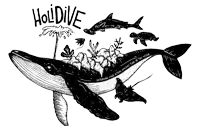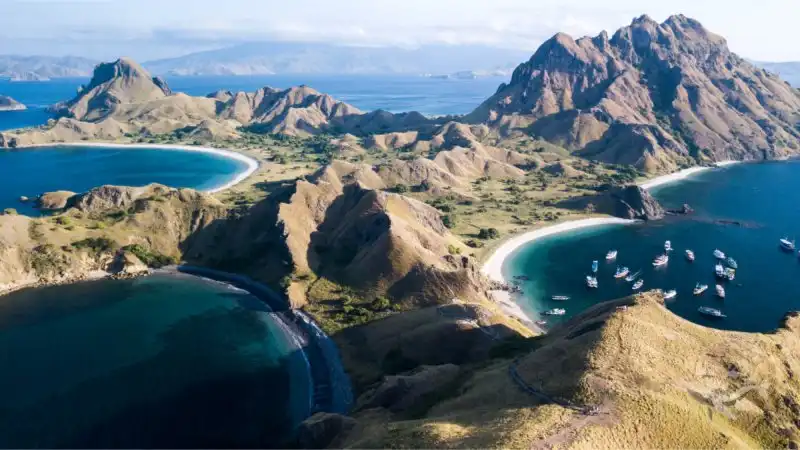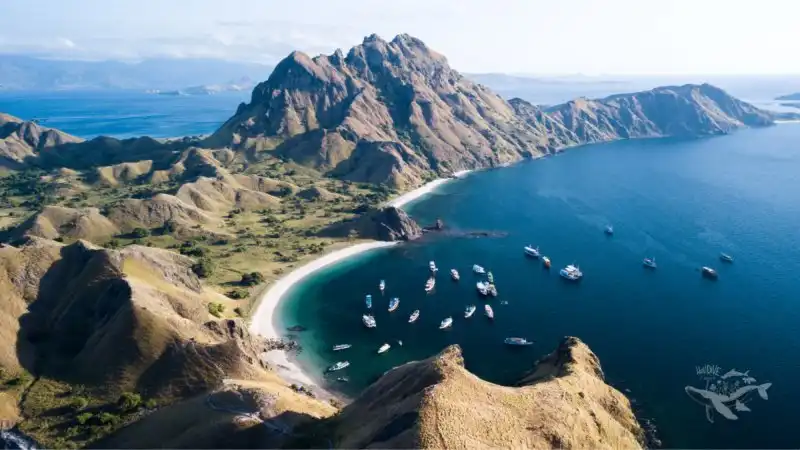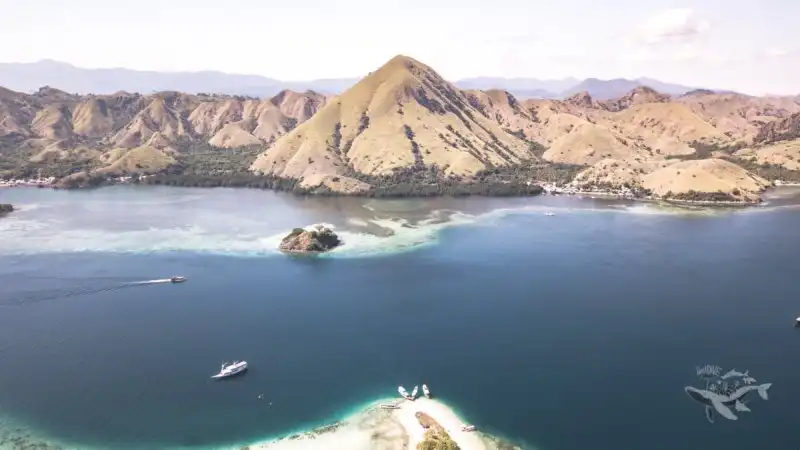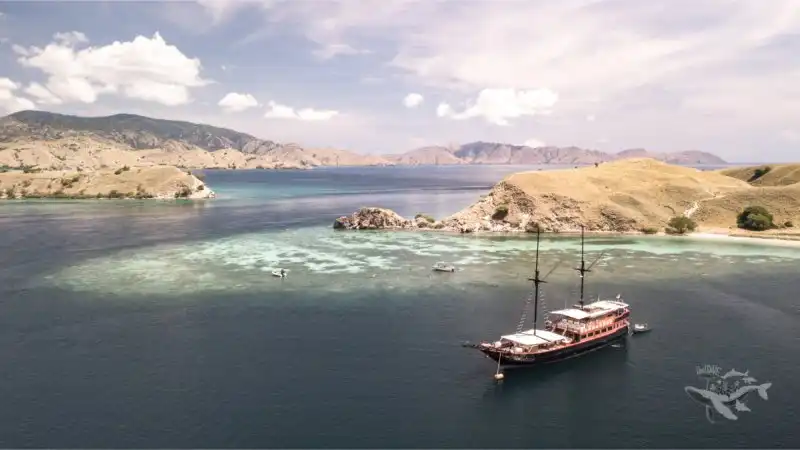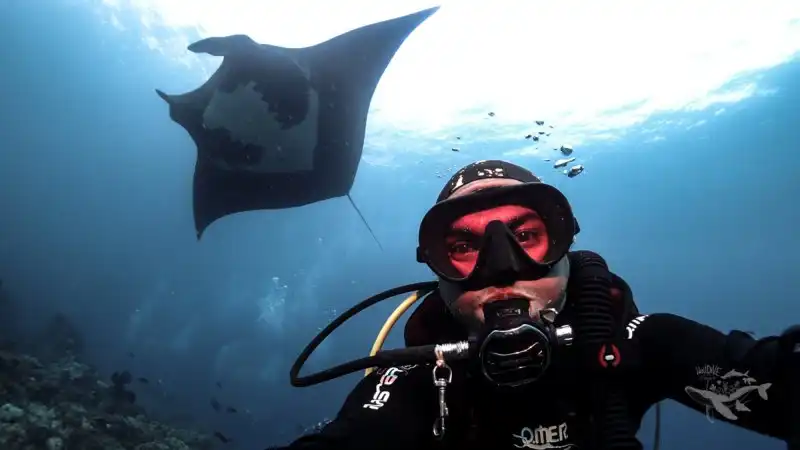DIVE IN KOMODO
Rugged, wild and packed with the promise of adventure, Komodo is one of Indonesia’s most famous diving destinations.
Manta rays, sharks, immense schools of fish and colorful reefs are just few of the stars of Komodo.
While Komodo is a popular liveaboard destination, staying on land in Labuan Bajo offers amazing sunsets night after night and increasing facilities for visitors.
The area is well known for its strong currents and is often recommended for divers with experience.
Komodo is relatively remote but if you want an adventure and incredible diving it should be at the top of your bucket list.
Expect to find an array of dive sites perfectly suited for drift diving.
Water temperature can be on the low side, sometimes dipping below 25°C, so bring extra layers of neoprene or a hood on top of a basic 3 mm suit to stay comfortable.
It is possible to dive year-round due to the dry weather.
THE BEST DIVE SITES
Tatawa Kecil – The small island of Tatawa Kecil has a big reputation with divers.
In fact, this underwater playground is a Komodo classic.
There’s a mix of swim-throughs, small caves, bommies and valleys which harbour huge numbers, and a huge diversity, of fish including reef sharks, jacks, batfish, snappers, groupers, sweetlips and occasionally a passing ray.
Cannibal Rock – A firm favourite with macro photographers and those wanting to see some of Komodo’s more unusual marine life.
Cannibal Rock is home to frogfish, pygmy sea horses, nudibranchs and coleman shrimp.
This seamount dive site is famous for invertebrate species and colorful soft corals and, being quite sheltered, it’s a good site if you want a break from drift diving.
The Cauldron – True to its name, The Cauldron looks like the top of a boiling pot and the crater offers many nooks and crannies to explore.
Explore the macro life down one side, then be prepared for the contrast when you reach the bottom and find yourself surrounded by big fish.
You’ll leave The Cauldron via the channel where dense schools of small to medium sized fish congregate.
Only after you’ve dived here will you truly understand why it’s so iconic.
Batu Bolong – Marine life gathers here as though the huge rock pinnacle is a magnet drawing them in.
In the blue, you’ll see sharks and tuna hunting while schools of smaller fish dart around in sync.
On the pinnacle itself the colors will astound you, along with the sheer number of small reef fish swimming in and out of corals trying to keep up with the action.
Castle Rock - At Castle rock the current can be very strong.
We recommend that only very experienced divers visit this site in strong current condition.
Several pinnacles rising from a shelf 20-24 meters deep and reaching almost the surface up to 4 meters deep, offer an unforgettable view.
Among the pinnacles huge schools of fusiliers and surgon fishes attract Giant and Jack trevallies, Spanish makarels and sometimes dolphins.
White tip and black tip sharks patrol the area, which is often visited by eagle and mant rays.
Most of divers wish to come back here again and again. The visibility is excellent.
LIVEABOARD or DIVE RESORT
There are so many Islands in the Komodo National Park!
With a Liveaboard you can visit more Islands and you can explore the Northern and Southern parts of the National Park that has more stunning dive sites!
Also you can dive before everyone come from the mainland.
AREA
The Komodo National Park consists of 26 small islands and 3 large islands which are Komodo Island, Rinca Island and Padar Island.
The park is located between the provinces of East Nusa Tenggara and West Nusa Tenggara in Indonesia.
The park was founded in 1980 with the objective of creating a conservation area for the Komodo dragon, the world’s largest lizard which is endemic to this area.
The park was then declared a World Heritage Site by UNESCO in 1991.
Komodo NP is one of the driest places in Indonesia and it gets extremely hot during May to October with a daily average temperature of 40°C.
The dry climate suits the Komodo dragon, and also gives the park an interesting landscape of rugged islands and Savannah-type vegetation.
Nutrient rich currents from the South Pacific Ocean flow through Komodo NP from the north, spilling into the Indian Ocean in the south.
This has encouraged a great marine biodiversity to develop, making the park one of the top places to scuba dive in Indonesia.
Liveaboard diving is the best way to experience the many dive sites which span over a very large area of 669 mi² (1,773 km²).
Manta rays and sharks are frequently sighted, and the coral reefs are healthy and teeming with marine life.
GETTING THERE
Labuan Bajo is the nearest airport and is serviced by flights from Bali, Jakarta and Makassar.
Alternatively, there are several ferries and speedboats which depart from Sape and also tourist boats which travel from other islands in Indonesia like Lombok.
Liveaboards depart from Labuan Bajo harbour, where you'll also find accommodation and shore-based operators. Ask for an airport pick up for the quickest and easiest option.
MAIN AIRPORT
Komodo Airport (LBJ)
Private Trip
- Return transfer in Sorong
- Stay in AC cabins on Twin sharing basis
- Fullboard Meals, Coffe, Tea and Mineral Water
- 3x dives per day, subject to sea condition & distance
- Tanks, Weights and Weight Belts
- Service of Dive Master for every 6 divers
Liveaboard
- Return transfer in Sorong
- Stay in AC cabins on Twin sharing basis
- Fullboard Meals, Coffe, Tea and Mineral Water
- 3x dives per day, subject to sea condition & distance
- Tanks, Weights and Weight Belts
- Service of Dive Master for every 6 divers
Open Trip
- Return transfer in Sorong
- Stay in AC cabins on Twin sharing basis
- Fullboard Meals, Coffe, Tea and Mineral Water
- 3x dives per day, subject to sea condition & distance
- Tanks, Weights and Weight Belts
- Service of Dive Master for every 6 divers
Now On Board
Available
NOTE
- Certified Divers
- Sign - General Release Dive Indonesia
- Sign - Liability Release and Assumption of Risk Agreement for Dive Center / Dive Resort / Boat Travel / Liveaboard
- Maximum Depth 30 Meters, Maximum Time 60 Minutes/dive. Multi Level Dive.
- DSMB (Delay Surface Marker Buoy) Is Recommended For You to Carry
- Follow Your Dive Guide, Solo Dive Is Prohibited
- Don’t Forget To Analize Your Nitrox Tank and fill the Nitrox Log Form
- Please Wait 18-24 Hour before Flight
- Do Not Surface Under the Boat
- Disallow Deco Dives
- Agreed Terms and Conditions
